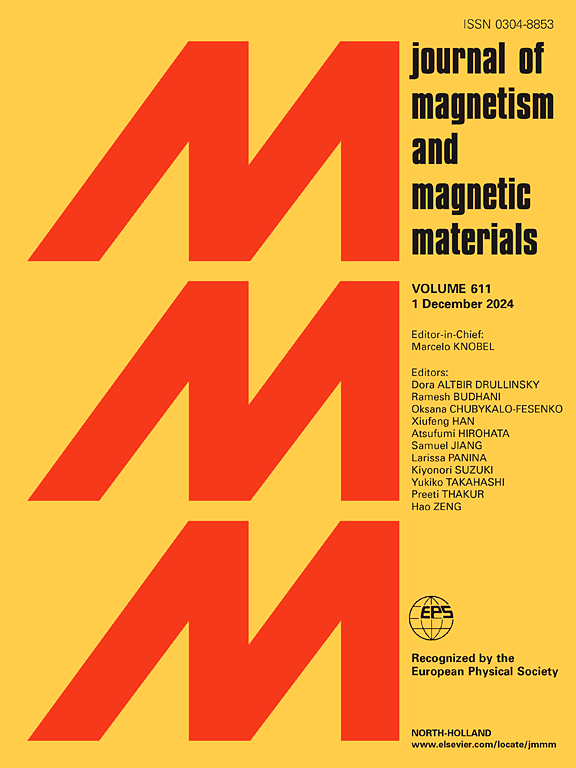Effect of Nb doping on phase transition and magnetocaloric effect in Hf0.84Ta0.16-xNbxFe2 alloys
IF 2.5
3区 材料科学
Q3 MATERIALS SCIENCE, MULTIDISCIPLINARY
引用次数: 0
Abstract
Hf-based Laves phase alloys, particularly the HfFe2 system, have garnered significant attention due to their diverse magnetic and structural properties, showing great potential in magnetic refrigeration and thermal expansion control. This study investigates the effect of Nb substitution on the magnetic transitions and magnetocaloric effects (MCE) of Hf0.84Ta0.16-xNbxFe2 alloys. With increasing Nb content, lattice parameters vary anisotropically, and the transition temperature increases gradually with an evolution from first-order (FOMT) to second-order magnetic transition (SOMT). Maximum magnetic entropy changes of −3.99J kg−1 K−1 and −3.34 J kg−1 K−1 observed for alloys with x = 0 and x = 0.04 undergoing FOMT under a 5 T magnetic field. Furthermore, the study highlights the coexistence of ferromagnetic and antiferromagnetic phases in FOMT and identifies a critical concentration of the FOMT/SOMT border with x = 0.04 by Arrott plots and the field exponent of magnetic entropy change. These findings offer new insights into tailoring magnetic transition and MCE properties of Hf-based alloys, advancing the development of efficient magnetic refrigeration materials.
Nb掺杂对Hf0.84Ta0.16-xNbxFe2合金相变和磁热效应的影响
hf基Laves相合金,特别是HfFe2体系,由于其不同的磁性和结构性能,在磁制冷和热膨胀控制方面显示出巨大的潜力,引起了人们的广泛关注。研究了Nb取代对Hf0.84Ta0.16-xNbxFe2合金磁跃迁和磁热效应的影响。随着铌含量的增加,晶格参数呈各向异性变化,转变温度逐渐升高,由一阶(fomo)向二阶(SOMT)转变。在5t磁场下,x = 0和x = 0.04合金的最大磁熵变化分别为- 3.99J kg - 1 K - 1和- 3.34 J kg - 1 K - 1。此外,研究强调了FOMT中铁磁相和反铁磁相的共存,并通过Arrott图和磁场熵变化指数确定了FOMT/SOMT边界x = 0.04的临界浓度。这些发现为hf基合金的定制磁转变和MCE性能提供了新的见解,推动了高效磁制冷材料的发展。
本文章由计算机程序翻译,如有差异,请以英文原文为准。
求助全文
约1分钟内获得全文
求助全文
来源期刊

Journal of Magnetism and Magnetic Materials
物理-材料科学:综合
CiteScore
5.30
自引率
11.10%
发文量
1149
审稿时长
59 days
期刊介绍:
The Journal of Magnetism and Magnetic Materials provides an important forum for the disclosure and discussion of original contributions covering the whole spectrum of topics, from basic magnetism to the technology and applications of magnetic materials. The journal encourages greater interaction between the basic and applied sub-disciplines of magnetism with comprehensive review articles, in addition to full-length contributions. In addition, other categories of contributions are welcome, including Critical Focused issues, Current Perspectives and Outreach to the General Public.
Main Categories:
Full-length articles:
Technically original research documents that report results of value to the communities that comprise the journal audience. The link between chemical, structural and microstructural properties on the one hand and magnetic properties on the other hand are encouraged.
In addition to general topics covering all areas of magnetism and magnetic materials, the full-length articles also include three sub-sections, focusing on Nanomagnetism, Spintronics and Applications.
The sub-section on Nanomagnetism contains articles on magnetic nanoparticles, nanowires, thin films, 2D materials and other nanoscale magnetic materials and their applications.
The sub-section on Spintronics contains articles on magnetoresistance, magnetoimpedance, magneto-optical phenomena, Micro-Electro-Mechanical Systems (MEMS), and other topics related to spin current control and magneto-transport phenomena. The sub-section on Applications display papers that focus on applications of magnetic materials. The applications need to show a connection to magnetism.
Review articles:
Review articles organize, clarify, and summarize existing major works in the areas covered by the Journal and provide comprehensive citations to the full spectrum of relevant literature.
 求助内容:
求助内容: 应助结果提醒方式:
应助结果提醒方式:


